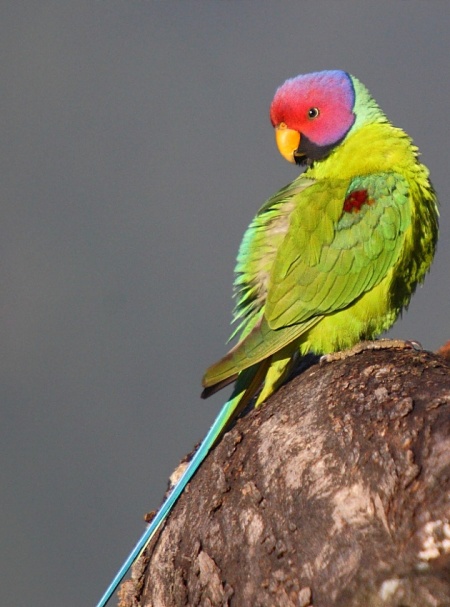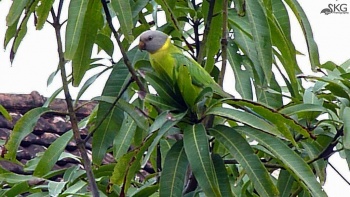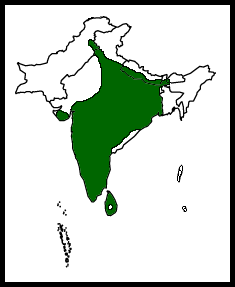
- Psittacula cyanocephala
Identification
33–37 cm (13-14½ in); tail 22 cm (8½ in)
Male'
- Red head
- Purplish-blue on the back of the crown, nape and cheeks
- Black chin stripe
- Narrow black neck collar
- Red shoulder patch
- Bluish-green tail and rump (white tips to tail)
- Orange-yellow upper mandible
- Black lower mandible
Female
- Grey head
- Yellow upper mandible ( the female lacks the neck collar, chin stripe and shoulder patch of the male)
Juveniles: have a green head and both mandibles are yellow.
Similar Species
Males are unmistakable, females could be confused with Blossom-headed Parakeet but ranges are probably not overlapping.
Distribution
| Found in the Indian Subcontinent, mainly in India (except Thar desert and East), Sri Lanka, also in the hill zone of Nepal and West Bhutan, North East Pakistan and maybe in West Bangladesh. Common in parts of its range. | |
| Legend |
Taxonomy
Usually regarded as monotypic[5].
From north to south the head and rump of the birds are becoming darker, but this seems to be clinal. Proposed subspecies bengalensis (North India) therefore not accepted by most authors.
Habitat
Moist deciduous forest, open woodland and adjacent clearings and cultivations. Found in from the lowlands up to ca. 1300m.
Behaviour
Diet
A quite frugivorous parakeet, also taking small to large seeds. Sometimes seen in cultivated area in flocks of several hundred, bringing damage to crops (rice, sorghum, maize, vegetables and orchards).
Breeding
Breeding season is from December to April, in Sri Lanka also sometimes from July to August. The nest is made in tree holes, often in small colonies in a group of trees. 4 - 5 eggs are laid, rarely 6. Incubation takes 24 days, the nestling period 6 weeks.
Movements
The species is resident, but some food-related movement can occur.
Vocalisation
Recording by Alok Tewari
Sat Tal Forest, Alt. 5500 ft. Uttarakhand Himalayas, India, April-2017
Call given by two birds while feeding during mid-morning.
References
- Rasmussen, P.C. and Anderton, J.C. 2005. Birds of South Asia. The Ripley Guide. Washington D.C. and Barcelona: Smithsonian Institution and Lynx Editions. ISBN 84-87334-67-9
- Grimmett, R., Inskipp, C. and Inskipp, T. 1998. Birds of the Indian Subcontinent. London: Christopher Helm. ISBN 0-7136-4004-9
- Kazmierczak, K. and Singh, R. 2001: A Birdwatcher's Guide to India. New Dehli: Oxford University Press. ISBN 019-565285-1
- del Hoyo, J., Elliott, A. and Sargatal, J. eds. 1997. Handbook of the Birds of the World. Vol. 4. Sandgrouse to Cuckoos. Barcelona: Lynx Edicions. ISBN 84-87334-22-9
- Clements, J. F., T. S. Schulenberg, M. J. Iliff, D. Roberson, T. A. Fredericks, B. L. Sullivan, and C. L. Wood. 2017. The eBird/Clements checklist of birds of the world: v2017, with updates to August 2017. Downloaded from http://www.birds.cornell.edu/clementschecklist/download/
Recommended Citation
- BirdForum Opus contributors. (2025) Plum-headed Parakeet. In: BirdForum, the forum for wild birds and birding. Retrieved 29 April 2025 from https://www.birdforum.net/opus/Plum-headed_Parakeet
External Links
GSearch checked for 2020 platform.1






